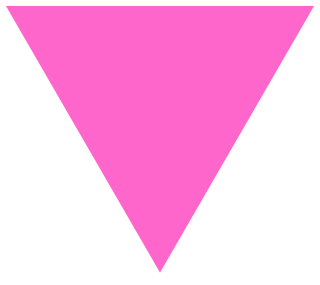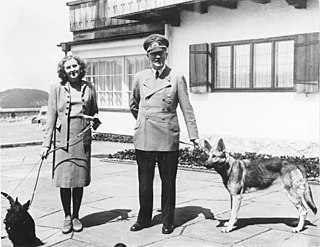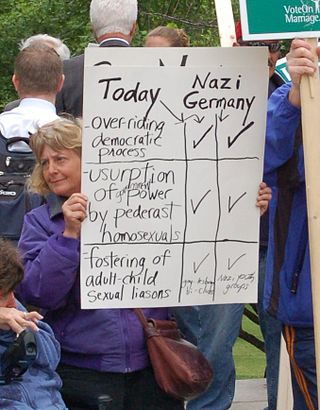
Before 1933, male homosexual acts were illegal in Germany under Paragraph 175 of the German Criminal Code. The law was not consistently enforced, however, and a thriving gay culture existed in major German cities. After the Nazi takeover in 1933, the first homosexual movement's infrastructure of clubs, organizations, and publications was shut down. After the Röhm purge in 1934, persecuting homosexuals became a priority of the Nazi police state. A 1935 revision of Paragraph 175 made it easier to bring criminal charges for homosexual acts, leading to a large increase in arrests and convictions. Persecution peaked in the years prior to World War II and was extended to areas annexed by Germany, including Austria, the Czech lands, and Alsace–Lorraine.

A pink triangle has been a symbol for the LGBT community, initially intended as a badge of shame, but later reclaimed as a positive symbol of self-identity. In Nazi Germany in the 1930s and 1940s, it began as one of the Nazi concentration camp badges, distinguishing those imprisoned because they had been identified by authorities as gay men. In the 1970s, it was revived as a symbol of protest against homophobia, and has since been adopted by the larger LGBT community as a popular symbol of LGBT pride and the LGBT movements and queer liberation movements.

Nazi concentration camp badges, primarily triangles, were part of the system of identification in German camps. They were used in the concentration camps in the German-occupied countries to identify the reason the prisoners had been placed there. The triangles were made of fabric and were sewn on jackets and trousers of the prisoners. These mandatory badges of shame had specific meanings indicated by their colour and shape. Such emblems helped guards assign tasks to the detainees. For example, a guard at a glance could see if someone was a convicted criminal and thus likely of a tough temperament suitable for kapo duty.

The Homomonument is a memorial in the centre of Amsterdam, the capital of the Netherlands. It commemorates all gay men and lesbians who have been persecuted because of their sexual orientation. Opened on 5 September 1987, it was the first monument in the world to commemorate gays and lesbians who were killed by the German Nazi regime.

The Hidden Hitler is a 2001 book by German professor and historian Lothar Machtan. The German original was published by Alexander Fest Verlag, while the English-translated version was published by Basic Books in New York City (ISBN 0-465-04308-9).
Holocaust victims were people targeted by the government of Nazi Germany based on their ethnicity, religion, political beliefs, disability or sexual orientation. The institutionalized practice by the Nazis of singling out and persecuting people resulted in the Holocaust, which began with legalized social discrimination against specific groups, involuntary hospitalization, euthanasia, and forced sterilization of persons considered physically or mentally unfit for society. The vast majority of the Nazi regime's victims were Jews, Sinti-Roma peoples, and Slavs but victims also encompassed people identified as social outsiders in the Nazi worldview, such as homosexuals, and political enemies. Nazi persecution escalated during World War II and included: non-judicial incarceration, confiscation of property, forced labor, sexual slavery, death through overwork, human experimentation, undernourishment, and execution through a variety of methods. For specified groups like the Jews, genocide was the Nazis' primary goal.
Homophobic propaganda is propaganda based on homonegativity and homophobia towards homosexual and sometimes other non-heterosexual people. Such propaganda supports anti-gay prejudices and stereotypes, and promotes social stigmatization or discrimination. The term homophobic propaganda was used by the historian Stefan Micheler in his work Homophobic Propaganda and the Denunciation of Same-Sex-Desiring Men under National Socialism, as well as other works treating the topic.
Watchmen on the Walls is an international evangelical ministry based in Riga, Latvia. It describes itself as "the international Christian movement that unites Christian leaders, Christian and social organizations and aims to protect Christian morals and values in society." According to a Southern Poverty Law Center (SPLC) Intelligence report the group's name derives from the Old Testament book of Nehemiah, in which the "watchmen" guard the reconstruction of Jerusalem. "The cities they guard over today, say the contemporary Watchmen, are being destroyed by homosexuality."

The sexuality of Adolf Hitler, dictator of Germany from 1933 to 1945, has long been a matter of historical and scholarly debate, as well as speculation and rumour. There is evidence that he had relationships with a number of women during his lifetime, as well as evidence of his antipathy to homosexuality, and no evidence of homosexual encounters. His name has been linked to a number of possible female lovers, two of whom committed suicide. A third died of complications eight years after a suicide attempt, and a fourth also attempted suicide.

The Memorial to Homosexuals persecuted under Nazism in Berlin was opened on 27 May 2008.

Scott Douglas Lively is an American activist, author, and attorney, who is the president of Abiding Truth Ministries, an anti-LGBT group based in Temecula, California. He was also a cofounder of Latvia-based group Watchmen on the Walls, state director of the California branch of the American Family Association, and a spokesman for the Oregon Citizens Alliance. He unsuccessfully attempted to be elected as the governor of Massachusetts in both 2014 and 2018.
Josef Kohout was an Austrian Nazi concentration camp survivor, imprisoned for his homosexuality. He is best known for the 1972 book Die Männer mit dem rosa Winkel, which was written by his acquaintance Hans Neumann using the pen name Heinz Heger, which is often falsely attributed to Kohout. The book is one of very few first-hand accounts of the treatment of homosexuals in Nazi imprisonment. It has been translated into several languages, and a second edition published in 1994. It was the first testimony from a homosexual survivor of the concentration camps to be translated into English, and is regarded as the best known. Its publication helped to illuminate not just the suffering gay prisoners of the Nazi regime experienced, but the lack of recognition and compensation they received after the war's end.
Abiding Truth Ministries (ATM) is a United States 501(c)(3) non-profit organization founded by Scott Lively in Temecula, California in 1997. The ministry has been based in Springfield, Massachusetts, since 2008. Lively, an American author, attorney and activist, is noted for his opposition to LGBT rights and his involvement in the ex-gay movement. Lively has called for the criminalization of "the public advocacy of homosexuality" as far back as 2007. Along with Kevin E. Abrams, Lively co-authored the 1995 book The Pink Swastika, which states in the preface that "homosexuals [are] the true inventors of Nazism and the guiding force behind many Nazi atrocities." He is also directly linked to pending anti-gay legislation in Uganda, which would, if passed, make homosexual conduct punishable by a lengthy prison sentence or death. The Southern Poverty Law Center regards Abiding Truth Ministries as a hate group.

The Sydney Gay and Lesbian Holocaust Memorial Project was founded by a group of community activists. Over the years they raised funds and decided, with South Sydney City Council, on the site at Green Park in Darlinghurst, in Sydney, Australia. Darlinghurst is considered the heart of Sydney's gay and lesbian population. Green Park is adjacent to the Sydney Jewish Museum, which ensures that the memorial retains its historic meaning.

The Pink Triangle Park is a triangle-shaped mini-park located in the Castro District of San Francisco, California. The park is less than 4,000 square feet (370 m2) and faces Market Street with 17th Street to its back. The park sits directly above the Castro Street Station of Muni Metro, across from Harvey Milk Plaza. It is the first permanent, free-standing memorial in America dedicated to the thousands of persecuted homosexuals in Nazi Germany during the Holocaust of World War II.
Bryan Jonathan Fischer is the former Director of Issues Analysis for the American Family Association (AFA). He hosted the talk radio program Focal Point on American Family Radio and posted on the AFA-run blog Instant Analysis.
The AIDS–Holocaust metaphor is used by AIDS activists to compare the AIDS epidemic to the Holocaust. The comparison was popularized by Larry Kramer and ACT-UP, especially the organization's French chapter, as a way to garner sympathy for AIDS sufferers and spur research into the disease. Although the comparison is now "commonly heard" with regard to AIDS, critics maintain that it is a form of Holocaust trivialization.

Stormtrooper Families: Homosexuality and Community in the Early Nazi Movement (2015) is a book by the American historian Andrew Wackerfuss. It focuses on Nazism and homosexuality and received generally favorable reviews. The book was published by Harrington Park Press.

There is a widespread and long-lasting myth alleging that homosexuals were numerous and prominent as a group in the Nazi Party or the identification of Nazism with homosexuality more generally. It has been promoted by various individuals and groups from before World War II through the present, especially by left-wing Germans during the Nazi era and the Christian right in the United States more recently. Although some gay men joined the Nazi Party, there is no evidence that they were overrepresented. The Nazis harshly criticized homosexuality and severely persecuted gay men, going as far as murdering them en masse. Therefore, historians regard the myth as having no merit.

The Röhm scandal resulted from the public disclosure of Nazi politician Ernst Röhm's homosexuality by anti-Nazis in 1931 and 1932. As a result of the scandal, Röhm became the first known homosexual politician.













